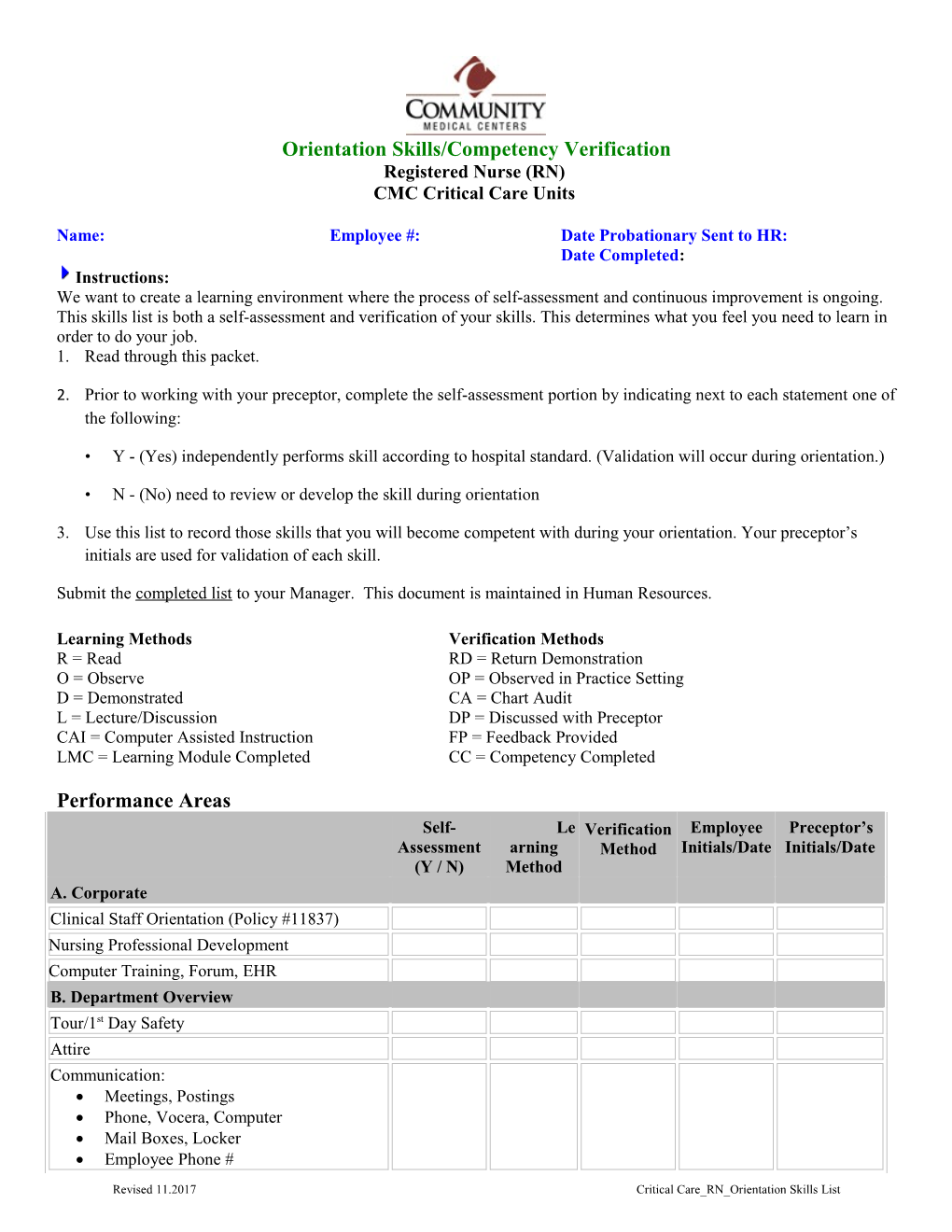Orientation Skills/Competency Verification
Registered Nurse (RN)
CMC Critical Care Units
Date Completed:
Instructions:
We want to create a learning environment where the process of self-assessment and continuous improvement is ongoing. This skills list is both a self-assessment and verification of your skills. This determines what you feel you need to learn in order to do your job.
- Read through this packet.
- Prior to working with your preceptor, complete the self-assessment portion by indicating next to each statement one of the following:
•Y-(Yes) independently performs skill according to hospital standard. (Validation will occur during orientation.)
•N- (No) need to review or develop the skill during orientation
- Use this list to record those skills that you will become competent with during your orientation. Your preceptor’s initials are used for validation of each skill.
Submit the completed list to your Manager. This document is maintained in Human Resources.
Learning Methods Verification Methods
R = Read RD = Return Demonstration
O = ObserveOP = Observed in Practice Setting
D = Demonstrated CA = Chart Audit
L = Lecture/DiscussionDP = Discussed with Preceptor
CAI = Computer Assisted InstructionFP = Feedback Provided
LMC = Learning Module Completed CC = Competency Completed
Performance Areas
/ Self-Assessment (Y / N) / Learning Method / Verification Method / Employee Initials/Date / Preceptor’s Initials/Date
A. Corporate / / /
Clinical Staff Orientation (Policy #11837)
Nursing Professional Development
Computer Training, Forum, EHR
B. Department Overview /
Tour/1st Day Safety /
Attire /
Communication:
- Meetings, Postings
- Phone, Vocera, Computer
- Mail Boxes, Locker
- Employee Phone #
C. Resource Management/Equipment
Alaris Pump (Policy#16925)
Bed, Wheelchair, Gurney, Recliner
Bladder Scanner (Policy#22919)
Blanket Warmer (Policy #12050)
Capnography Monitor/ EtCO2 Monitor(Policy#24711)
Crash Cart (Policy #11946)
Defibrillator (Policy#2.22)
Doppler
Interpreter on Wheels
PCA/Epidural Pump (Policy#12024)
POC Equipment (NOVA, glucometer, EPOC) (Policy #17394)
Portable Oxygen Tanks
Rapid Sequence Intubation Supplies (Policy#10858)
Safe Patient Handling
Sequential Compression Devices
Stationary/Transport Monitors & Equipment (Policy#11730)
Suction
Vein Finder/Ultrasound
D. Age Specific Education –Follow criteria appropriate to age groups
E. Performance Improvement & Service Excellence / / /
Unit Specific Indicators/PI projects /
Trends (HCAHPS, Core Measures, IRIS, Quality Indicators, etc.)
IRIS Notification System /
Patient Rights, Consents Policy#19337; 11942)
Customer Service and handling complaints/ Target100 (Policy#12166; 12144)
GetWell network
Palliative Care (Policy#21963)
F. Additional Resources / /
Safety/ Security/ Medical/Equipment/ Fire/ Disaster/ Haz Mat/ MSDS/ Infection Control/ Nutrition Manual /
G. Role Specific
Knowledge:
Intravenous Medication Admixture (Policy #11996)
Anticoagulation: Nomograms/Heparin Simulation
Arterial Blood Gas Interpretation
Basic Arrhythmia - Challenge Exam
EHR Downtime Documentation
Hemodynamic Monitoring: Basic Understanding /
Policy and Procedure (Lucidoc)
Procedural Resources /
Teaching Manuals /
Physician Privileging (MSO-NET) Privilege Inquiry /
Up-to-Date
Unit Communication: /
Patient Classification System /
SharePoint, Staff Meeting Binder, Unit Website /
Corporate Policy and Procedure
Capnography Guidelines (Policy #24711)
Code Blue/White—Response and Interventions (Policy #11945)
Critical Results Communication and Documentation (Policy #14332)
Epidural Injections and Continuous Infusions (Policy #11972) (PRL231)
Hand Hygiene (Policy #11856)
High Alert/High Risk Meds (Policy #16492)
Medication with Special Considerations (Policy #11984)
Pain Management (Policy #12010)
Patient Identification (Policy #12023)
Rapid Response Team Activation (Policy #11914)
Restraints and Seclusion (Policy #14355)
Standards of Practice – In Patient (Policy #14809; 24847)
Universal Protocol (Policy #12053)
Vasoactive IV infusion titration guidelines (Policy#11797)
Area/Unit Specific Policies and Procedures – Lucidoc – Critical Care/ ICU Stepdown Manual
Admission, Discharge, and Transfer: Critical Care (Policy #10183)
Competency Guidelines for CMC Critical Care Units (Policy #10445)
Critical Care Documentation for CMC Critical Care Units (Policy #10511)
Post-Op Care of the Critical Care Patient Communication and Disposition (Policy #11345)
Family Presence During Resuscitation (Policy #23760)
General Analgesia and Sedation: Adult Critical Care (Policy #12696) (PRL 1473)
Vasoactive Infusion Titration Guidelines – Critical Care (Policy #11797)
Visitation Critical Care Units (Policy #11802)
Skills / /
Analgesia and Pain Assessment
Arterial Blood Gas Drawing
Arterial Catheter: Maintenance and care
Arterial Catheter: Removal
Barcode Medication Administration
Bedside Mobility Assessment Tool/Progressive Mobility
Bio-psycho-social ICU assessment (advanced system assessments)
Blood and Blood Product Administration
Capnography Monitor / EtCO2 Monitor (Policy #24711)
Central Line Management (CLABSI Prevention) (Policy #19683; PICC and Central Line Quick Reference Guidelines) (PRL 1619)
Fecal Containment Device (insertion, care, maintenance)
Feeding Tubes (OG, NG, PEG,NJ, etc.) insertion, care, maintenance (Policy #11998; 12011; 22599)
Foley Care & Management (CAUTI Prevention) (Policy #22918; 22919) (PRL 1441)
Lab Draws & Lab Labeling (Policy #12005; 19683; 22923)
Infection Prevention (Policy #11856; 22560; 11958)
Intubation and RSI
Lead Placement
Modes of Oxygenation
Multi-dose vial 28 day dating from time of opening(Policy #11990)
Oral Care for unconscious patients (Policy #12013)
Palliative Care (Policy #21963; 24327)
Patient Controlled Analgesia
Patient Visitation Guidelines(Policy #11802)
PICC Line Care & Management (Policy #12004) (PRL 1493)
Preoperative Care, Universal Protocol, Timeout (Policy #12053)
Pressure Ulcer Risk Assessment & Prevention(Policy#12048)
Procedural Sedation (Policy #13539)
Regitine (Policy #16694)
Restraints(Policy #14355)
Sedation protocol and RASS (Policy #12696; RASS Reference Sheet)
Sepsis (PRL 1577)
Tracheostomy care, suction, capping (Policy #12055)
Venipuncture
Ventilator modes, alarms, and prevention of VAP (Policy #11794; 22753)
Attitudes:
Values the following:
- American Association of Critical Care Nursing (AACN) Standards
- American Nurses Association (ANA) Standards of Practice
- ANA Standards of Professional Performance
- ANA Code of Ethics
- California Nurse Practice Act: 2725
- Title 16: Standards of Competent Performance
- Title 22, 70215: Code of Regulation
Demonstrates and role models professional practice
Creates a positive and healthy practice environment
REQUIRED SIGNATURES:
Competency Verified By:
Initials / Preceptor’s Signature / DateSelf-Assessment Completed By:
* Please forward completed form to Human Resources with introductory evaluation.
Revised 11.2017Critical Care_RN_Orientation Skills List
